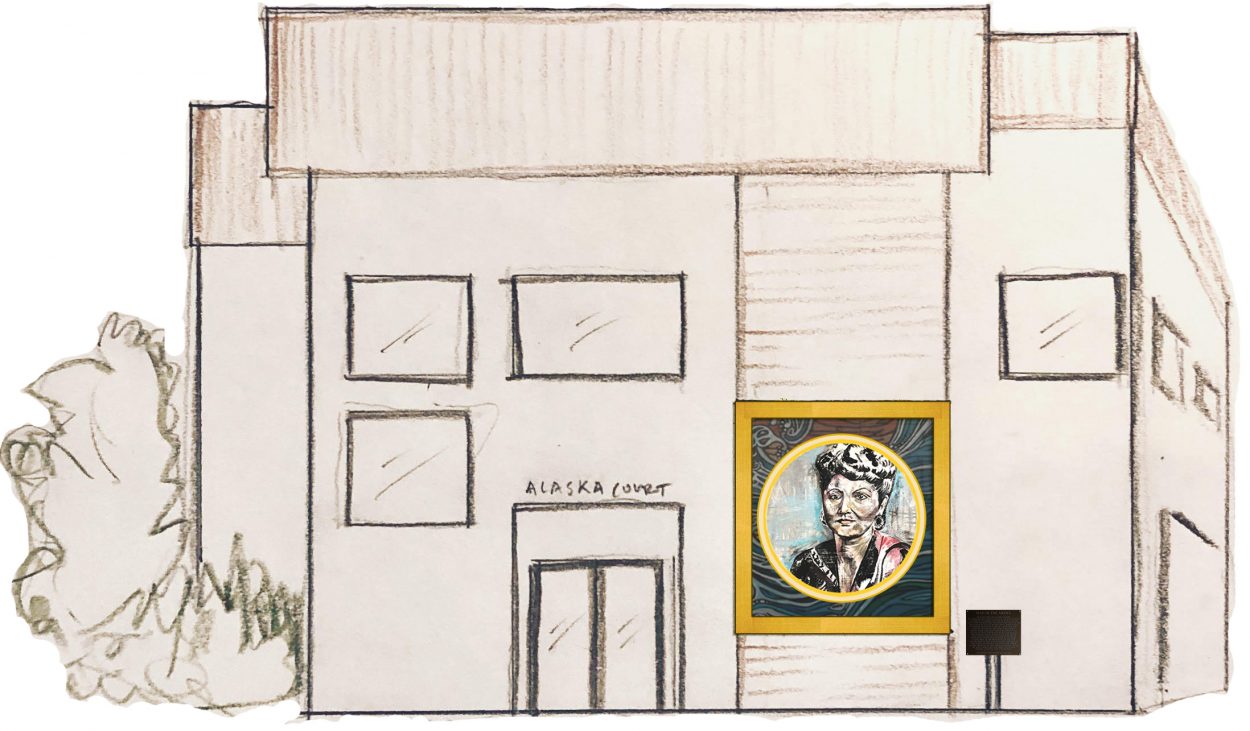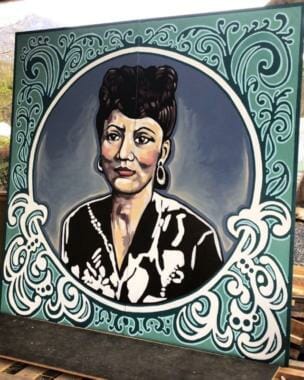
At a time when monuments of colonizers and enslavers are being debated and removed across the country, a mural is going up this July 4th in the birth place and on the birthday of a Native civil rights leader. The new mural in the Southeast Alaska community of Petersburg celebrates Elizabeth Peratrovich, her legacy as a Native Tlingit woman, and voice for equal rights.
Elizabeth Peratrovich was born on July 4, 1911, in Petersburg to a Tlingit family. At that time, being Native meant facing segregation and discrimination. Now, one 109 years later – to the day – Peratrovich will be memorialized with a new mural on the state courthouse building to honor her life and civil rights legacy.
“Elizabeth Peratrovich had a real gift with language and articulating the situation,” says Malena Marvin, who serves on the Petersburg Arts Council, which helped organize the funding for the mural. “And using her words to help make change at a really pivotal time in Alaska’s history.”
In 1945, as a 34-year-old mother of three, Peratrovich was an advocate for Native rights, and organized with the Alaska Native Sisterhood in Juneau. She testified before the Alaska Territorial Legislature – talking about her life, her friends, her children, and being barred from buying a home in Juneau – and advocating for an end to discrimination and equal rights for Native people.
Alaska Native people were barred from workplaces, buying land and living in certain neighborhoods. Signs in some storefronts read “No Dogs, No Natives.”
“Here’s the woman that, you know, 20 years before Martin Luther King did what he did, we have a woman that you know, her testimony was instrumental to the first anti-discrimination law that was passed in the United States of America,” said award-winning Haida artist Janine Gibbons, who painted the new mural. “And this woman was from Petersburg, Alaska.”

Many people say her speech inspired the passing of the anti-discrimination bill. Then-Alaska Governor Ernest Gruening signed the landmark legislation on February 16, 1945 – now celebrated as Elizabeth Peratrovich Day. The law effectively banned discrimination based on race.
The U.S. Treasury announced in fall of 2019, that its 2020 Native American $1 dollar coin would feature Peratrovich and honor the 75th anniversary of her famous testimony. People took notice.
Organizers came together in Petersburg to commission a mural in her honor and raised about $7,000 from donations around the state.
“In the painting she kind of, (it’s) like a classic Native Southeast look. We all have very prominent eyebrows,” Gibbons said with a laugh. “You can say a lot with just your eyebrows. It’s kind of Mona Lisa-like. She kind of has one eyebrow a little bit arched – like she’s asking a question. And then the other eyebrow is a bit softer so kind of like she’s listening and questioning at the same time. That was the look I wanted to have.”
In a nod to Petersburg cultural history, Gibbons merges both Native and Scandinavian aesthetics into the background.
In the process of painting the mural, Gibbons had to dive into the historical record, but also says she was immersed in the emotional experience and the generational trauma of Native communities.
“It’s really intense. Most people are not fully aware of what happened to people,” she said.
Native people faced discrimination in all sectors of society – even children.
Schools – especially boarding schools – removed Native children from their family, homes and heritage. “You had to give up all parts of who you were as a Native person,” Gibbons said. “You had to give everything up to go to a public school, right. It was segregated. And people really had to disguise themselves, to fit in.”
The system left many Native children without families. At a young age, Peratrovich herself suffered that fate. She was adopted by a white family and grew up in Ketchikan, but maintained a connection to her Tlingit heritage.
Gibbons relates to Peratrovich’s story deeply, as she and many of her friends growing up also came from generations of orphaned people.
“One of my best girlfriends, her grandmother and all of her siblings were born out at Blind Slough,” says Gibbons. “There was nine of them, and each one of those kids was taken legally, from their parents, and shipped to nine different parts of the country.”
The trauma of those experiences were rarely talked about, yet continue to reverberate through families and communities.
“So they were sent to boarding schools,” she explains. “They didn’t want shared knowledge. They took away your language, cut off your hair, they did the worst possible things you could imagine. And you know, people come back, and it’s like well, why didn’t my grandma teach me this or do that, and it’s like well they were tortured, you know, a lot of them. So it’s a big weight to carry.”
The vice president of the Petersburg Indian Association, Brenda Norheim was a lead organizer on the mural project. For Norheim, seeing Peratrovich honored on the courthouse is an important representation for Native cultural history.
“I can’t even put it into words,” Norheim said. “Thinking of what my grandparents went through, and my mom. It’s like when we put the totem poles up downtown years ago, it was a powerful, emotional moment that I never anticipated – just because of the heartache that people in our past had to go through. The suffering.”
Arts Council member Malena Marvin says organizers hope the mural will inspire dialogue and reflection on the lessons from the past, which are [particularly significant now, as the U.S. grapples with the history of racism and colonization, and many Confederate monuments are coming down.
“We’re at this time where we’re having a big national conversation about what we put in public, how we remember our history,” said Marvin. “And there are so many ways to remember our history. We just wanted to see the special gifts that Elizabeth Peratrovich brought to the conversation on race relations in Alaska.”
Organizers will continue to raise funds to add a carved Tlingit artisan frame around the mural and an educational plaque and create a website with more information and media on Peratrovich and her contemporaries.
Due to coronavirus concerns, the large celebration for the mural unveiling had to be scaled down. A short program will be held at the courthouse in Petersburg on Saturday, July 4. People are invited to come in person with masks and socially distanced, or watch on a livestream on Petersburg Arts Council Facebook page.